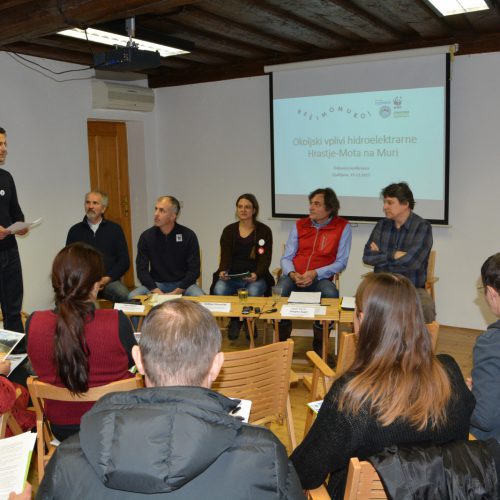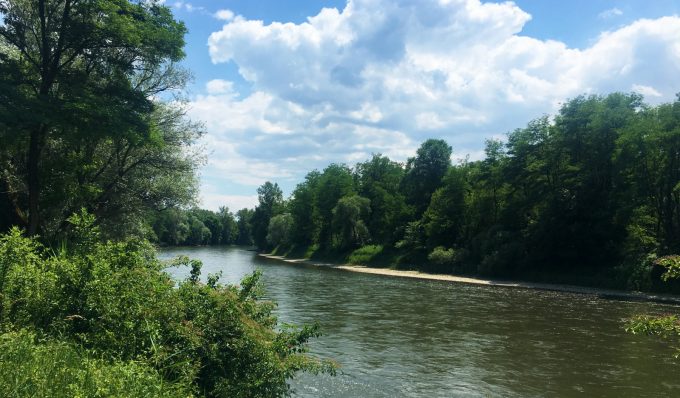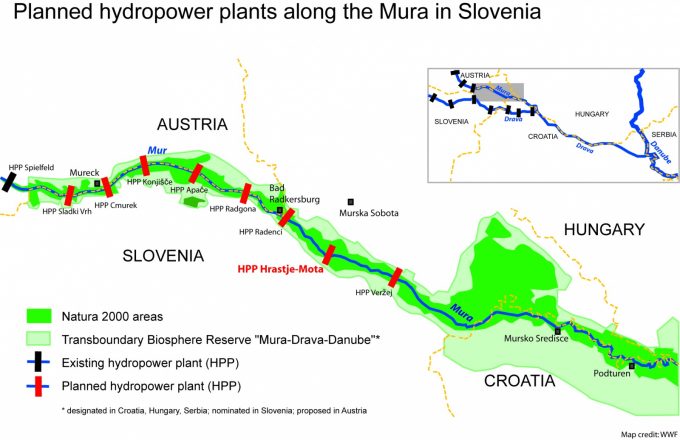News
Expert studies confirm: Environmental impacts of Hrastje-Mota dam on the Mura River larger than claimed!
International scientific review of the Environmental Report reveals major data deficits, incorrect assumptions and future legal conflicts
Ljubljana – Environmental scientists from Austria and Germany have just published their assessment of the Environmental Report (ER) for the State Spatial Plan for the planned hydropower dam Hrastje-Mota on the Mura River in Slovenia. Scientific review of the ER reveals major data deficiencies, a considerable lack of quality, and a number of incorrect assumptions. Because the ER underestimates the project’s impacts on protected fish species and floodplain forests legal conflicts are foreseen.
NGOs such as WWF, Moja Mura and Native Fish Society of Slovenia have been saying from the start that the dam’s negative impacts on the Mura River, the last big free-flowing river with the largest floodplain forests and highest fish diversity in Slovenia, are too big to allow the project’s implementation. Even the ER attests that the project has significant impacts on the environment. However, NGOs claim that the scope of the impacts on Natura 2000 habitats and species have not been assessed correctly in the ER. Therefore, they have commissioned two independent studies from international scientists to evaluate the ER with regard to endangered fish species and floodplain forests.
“The ER underestimates the impacts on eight key fish species, while the potential impact on four additional key species has not been assessed at all. The report fails to assess the downstream effects of the planned dam on fish populations and underestimates or ignores potential impacts at the transboundary level, in Natura 2000 areas along the Mura in Austria, Croatia and Hungary. It also proposes grossly inadequate mitigation measures of the potential impacts,” says the fish expert Assoc. Prof. Dr. Steven Weiss from the Institute of Zoology from the Karl-Franzens University Graz in Austria.
“The ER lacks a proper assessment of impacts on floodplain forests. The negative impacts on the softwood forest are even more than twice as high as claimed in the report, which makes the compensation measures impossible. The ER also neglects appropriate assessment of downstream as well as potential transboundary impacts on floodplain forests in Natura 2000 sites in Croatia and Hungary,” says the floodplain forest expert Assoc. Prof. Dr. Gregory Egger from the Institute for Geography und Geoecology, Department of Wetland Ecology, from the University of Karlsruhe (KIT) in Germany.
“Such high-impact projects in Natura 2000 areas require proper and comprehensible planning and assessment as a basis for decision. The highest possible legal standards must be applied to a river and an area of such international conservation significance as the Mura,” both scientists concluded.
“The results of the studies unfortunately surpass our biggest fears. We believe that the environmental impacts on fish species and floodplain forests have been assessed as harmless as possible in order to be able to argue for sufficient compensation measures later in the legal permitting process. However, the independent experts state that the impacts from such a project are simply too large to be able to compensate,” said Andreja Slameršek, expert for legal and professional matters of the “Save the Mura” campaign and president of the Slovenian Native Fish Society.
The Mura in Slovenia is a key part of the largest natural riverine ecosystem in central Europe, including the free-flowing stretches of the Mura, Drava and Danube rivers encompassing over 1000 km from Spielfeld in Austria to the Iron Gate on the Romanian-Serbian border. Large parts of this unique system are to be protected as a future 5-country UNESCO Biosphere Reserve “Mura-Drava-Danube” between Austria, Slovenia, Croatia, Hungary and Serbia. It is the so-called “Amazon of Europe”, one of Europe´s last refuges for wildlife.
“The planned Hrastje-Mota dam would be the first dam on the Slovenian Mur to interrupt the free-flow of water, sediments and migratory fish of the larger Mura-Drava-Danube system. We were astonished to learn that the impact assessment literally stops at the Austrian border as well as the downstream borders of Croatia and Hungary. This is in clear violation of Slovenia´s international obligations. Rather than trivialize or neglect such impacts, as done in the ER, we would expect comprehensive assessment at the transboundary level. The Mura-Drava-Danube river ecosystem is too valuable on a European scale to be frivolously sacrificed for short term economic benefits”, said Arno Mohl from WWF.
NGOs will continue to pressure the Slovenian government to act immediately and demand from investors a thorough revision of the ER in accordance with international scientific and professional standards taking into account all Natura 2000 species and habitats, including cross-border impacts.
“The findings of the experts are alarming and show that the impacts of the planned dam on endangered fish species and floodplain forests are highly underestimated. We believe that in the interest of our nature and people from Pomurje region as well as our neighboring countries that the assessment of the impacts should be done correctly and in a most comprehensive manner. Therefore, we urgently call on the minister of environment Irena Majcen to ensure that this happens,” concluded Stojan Habjanič, coordinator of the “Save the Mura” campaign and President of Moja Mura.
Expert reports for download:
Expert report - Floodplain Forests (G. Egger)
Expert report - Fish species (S. Weiss)



